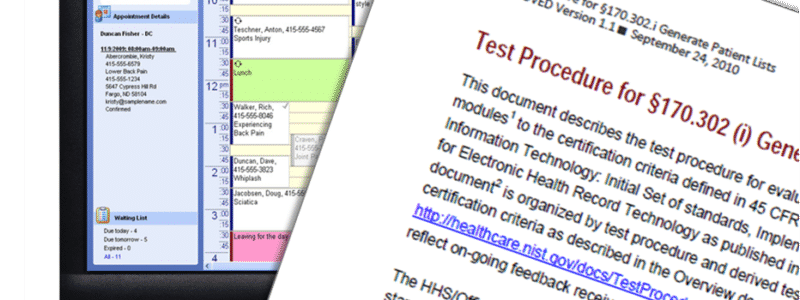The HITECH Act has brought a huge rush of EHR vendors into the market. And separating the good from the bad is ultimately found in the details where there’s an intersection of ease of use and advanced functionality. One such example is with the Meaningful Use Certification Test Criteria procedure §170.302.i regarding the generation of patient lists based on the problem list, medication list, demographics and laboratory test results. The purpose behind this section of the meaningful use criteria is to be able to follow up on patients having certain diagnoses, risk factors, etc. While most EHR systems have the ability to generate these lists, very few of them provide a good system for contacting the patients and, most importantly, tracking patient compliance. It’s just one of those marketable features that are unfortunately too often missed in the EHR software design process.
During the time that I was running Westland Medical Systems, subsequently PracticeOne, I had the opportunity to work with some large OB/GYN and other primary care practices where patient recall and follow-up was a major task of the EHR system. The importance of having a comprehensive system that can automate this area cannot be overemphasized.
§170.302.i directly addresses an EHR system’s ability to manage patient recalls
Consider the example of receiving a laboratory result for a pap smear where the results are abnormal. There are three categories that describe the abnormality: ASCUS (usually the result of an infection), LGSIL (sometimes called CIN I) and HGSIL (which can be either CIN II or CIN III). The most important point is that whether the pap result is normal or one of the abnormal results, the follow-up protocol with the patient will be different. The best EHR Systems will automatically suggest the proper follow-up protocol based on the result. Other EHR’s will allow you to manually create a tickler or reminder. Keep in mind that here is where a good EHR follow-up system goes much further than the functionality outlined in§170.302.i in that follow-up ticklers need to be created in real-time, not just generated from data stored in the patient database.
Once a protocol is selected, or a tickler is created, how does the medical practice follow-up to make sure the patient comes back in for the necessary treatment? Take our pap smear example. If the result was an ASCUS (result indicates an infection) then the patient would most likely need to come back into the practice right away and be prescribed an antibiotic. The best EHR systems will route a message to the appointment desk and/or perhaps create a script for the prescription for the physician to sign. If the result is a CIN I then a tickler for the patient to return to the practice in three or six months for another pap smear might be appropriate. In this case the better EHR systems will create a tickler with the proper follow-up date so that the patient will be contacted via either a letter or phone call to schedule the required appointment and follow-up laboratory order.
Patient communication via an EHR’s patient access portal can help increase proper follow-up too

Tracking patient compliance via an effective EHR patient recall and follow-up system
How the EHR system tracks the compliance or non-compliance of the patient recall is a final measure of the EHR system’s success on this topic. What happens if the patient does not return to the medical practice for follow-up care? A good EHR system will automatically track compliance and funnel the non-compliant recalls into a follow-up tickler list for further action. There is a wide range of methods marking compliance, based on which EHR system you have implemented. However, the best EHR systems will have a more automated way of noting the compliance. For example, in the case of our pap smear recall, the recall should be marked as completed when the follow-up pap smear is performed and the new results received.
Note that, while many EHR Systems may provide various capabilities for patient follow-up and compliance tracking, many times the system implementations fall short of capabilities offered. §170.302.i on generating patient lists is just one example of a meaningful use criteria that specifies a software function that can be much more user-friendly and useful with some additional thought and effort on the part of the vendor. Other capabilities such as problem, medication and allergy lists can also be designed to both meet the minimal meaningful use certification criteria and make life easier for users.
A third-party consultant with experience in practice management and EHR software applications can help vendors improve their application functionality and help practices take full advantage of the capabilities of the software. In the long run, this will result in improved return on investment on an EHR purchase.

